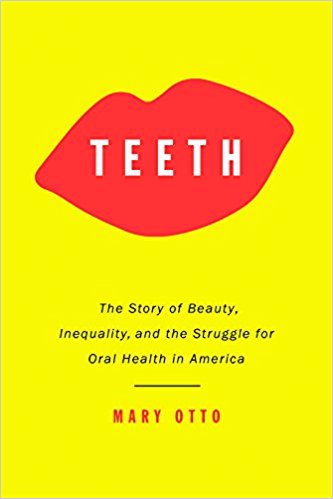
The mouth is the gateway to the body, and yet we treat oral health care as somehow different and apart from overall health care.
Why?
If you have had a routine physical lately, chances are your doctor did not ask if you are brushing, flossing, and receiving regular teeth cleanings, even though we know poor oral health can lead to diabetes, heart disease, osteoporosis, and many other maladies.
The most prevalent chronic disease for adults and children in the United States today?
Tooth decay.
A new book, Teeth: The story of beauty, inequality, and the struggle for oral health in America, by Mary Otto describes why we have chosen to treat oral health differently from the rest of our body, and reveals in compelling stories and dispassionate data why our inadequate focus on oral health care in America has led to perhaps our biggest health care crisis.
Why do dentists and doctors practice separately in the United States?
Otto spoke with the Atlantic Monthly back in March of this year, describing the schism between dentists and doctors as going all the way back to the 1840s. Two pioneering dentists of the time, Chapin Harris and Horace Hayden, approached the University of Baltimore to integrate dental care into the College of Medicine at the university.
The dentists were rejected in a “historic rebuff,” told that dentistry was “of little consequence” to the overall body. These dentists and others that soon followed moved on to establish their own practice training and credentials. “Dentists still drill and fill teeth and physicians still look at the body from the tonsils south. Medical and dental education is still provided separately almost everywhere in this country and our two systems have grown up to provide care separately, too.”
Isolated from traditional medicine, the vast majority of dental care in America is provided through a patchwork quilt of individual private practices. This entrepreneurial model has a number of benefits for practitioners, and can lead to a high quality of care for many who can buy into the system.
But for those with poor access to the system, it can have tragic results.
12 year-old Deamonte Driver’s story from a decade ago is weaved into Teeth as a cautionary tale of what can happen in a society when we neglect to provide accessible, affordable, preventative oral health care to all.
Young Deamonte, living in Maryland, had tooth aches and pains that were neglected for far too long, ultimately leading to bacteria from an abscessed tooth in his mouth traveling to his brain and killing him.
Had his painful situation been caught and treated earlier, what could have been an $80 bill for tooth extraction quickly turned into hospital bills exceeding $200,000, and led most tragically to the passing of a youngster from a health issue that was easily and eminently preventable.
Inadequate preventative oral health care is a problem across the country, and continues to bedevil North Carolina in particular. A 2013 Pew Charitable Trust Report found that North Carolina children from low-income families may be less likely to receive preventative dental care than their peers across the nation, placing our state in the bottom five of all states for using proven school-based dental sealants to prevent tooth decay.
Far too many low-income children are not receiving adequate oral health care. Otto shares findings from the National Health and Nutrition Examination Study revealing that nearly one-quarter of preschool-aged kids in America has decay in their baby teeth.
There are also profound racial disparities in oral health care. Black and Hispanic children are twice as likely as white children to go without treatment for decay.
A number of innovative approaches designed to improve access to oral health care are included in a recent report from the North Carolina Oral Health Collaborative. From pairing private practice dentists with children at high poverty elementary schools, to investing in mobile dental health clinics, there are promising practices emerging across the state. Our own Care Ring Physicians Reach Out program is included in this report as another way to encourage private practice dentists to give back to serve others.
Solving America’s oral health care crisis is related to our need to address income inequality and improve economic mobility opportunities for all.
We know that poor oral health has a negative multiplier effect. Children with untreated dental caries may not only experience pain, but also may not smile or engage in social activities as much as their peers, which can lead to poor academic performance and then a host of challenges as an adult.
As the Charlotte region wrestles with how we can improve on our very poor ranking for economic mobility, especially for minority populations, we should keep access to basic preventative health care services – including preventative oral health care – front and center in our plans to move forward.
#teeth #oralhealthcare #toothdecay #lowincomechildren #innovated #healthcarecrisis #children #economicmobility #charlotte
